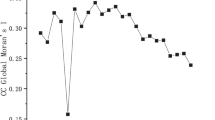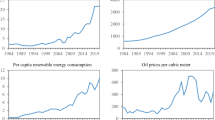Abstract
The present study is aimed to explore the relationship between coal consumption, industrial production, and CO2 emissions in China and India for the period of 1971–2011. The structural break unit root test and cointegrating approach have been applied. The direction of causal relationship between the variables is investigated by applying the VECM Granger causality test. Our results validate the presence of cointegration among the series in both countries. Our results also validate the existence of inverted U-shaped curve between industrial production and CO2 emissions for India, but for China, it is a U-shaped relationship. Coal consumption adds in CO2 emissions. The causality analysis reveals that industrial production and coal consumption Granger cause CO2 emissions in India. In the case of China, the feedback effect exists between coal consumption and CO2 emissions. Due to the importance of coal in China and India, any reduction in coal consumption will negatively affect their industrial value added as well as economic growth.



Similar content being viewed by others
Notes
Real industrial value added (constant 2005 US$) indicates value added in mining, manufacturing, construction, electricity, water, and gas. Value added is the net output of a sector after adding up all outputs and subtracting intermediate inputs. It is calculated without making deductions for depreciation of fabricated assets or depletion and degradation of natural resources. The origin of the value added is determined by the International Standard Industrial Classification (ISIC). Data are in constant 2005 US dollars.
References
Alam MJ, Begum IA, Buysse J, Rahman S, Van Huylenbroeck G (2011) Dynamic modeling of causal relationship between energy consumption, CO2 emissions and economic growth in India. Renew Sust Energ Rev 15:3243–3251
Ang JB (2007) CO2 emissions, energy consumption, and output in France. Energy Policy 35:4772–4778
Apergis N, Payne JE (2009) CO2 emissions, energy usage, and output in Central America. Energy Policy 37:3282–3286
Apergis N, Payne JE (2010a) The causal dynamics between coal consumption and growth: evidence from emerging market economies. Appl Energy 87:1972–1977
Apergis N, Payne JE (2010b) Coal consumption and economic growth: evidence from a panel of OECD countries. Energy Policy 38:1353–1359
Apergis N, Payne JE (2010c) The emissions, energy consumption, and growth nexus: evidence from the commonwealth of independent states. Energy Policy 38:650–655
Arouri MH, Ben Youssef A, M’Henni H, Rault C (2012) Energy consumption, economic growth and CO2 emissions in Middle East and North African countries. Energy Policy 45:342–349
Banerjee A, Dolado J, Mestre R (1998) Error-correction mechanism test for cointegration in a single-equation framework. J Time Ser Anal 19:267–283
Baum CF (2004) A review of Stata 8.1 and its time series capabilities. Int J Forecast 20:151–161
Bayer C, Hanck C (2013) Combining non-cointegration tests. J Time Ser Anal 34:83–95
Bloch H, Rafiq S, Salim R (2012) Coal consumption, CO2 emission and economic growth in China: empirical evidence and policy responses. Energy Econ 34:518–528
Boswijk HP (1994) Testing for an unstable root in conditional and structural error correction models. J Econ 63:37–60
BP (2012a). BP Statistical Review of World Energy June 2012. London, UK
BP (2012b) BP Energy Outlook 2012. London, UK
Chang CC (2010) A multivariate causality test of carbon dioxide emissions, energy consumption and economic growth in China. Appl Energy 87:3533–3537
Chattopadhyay D (2014) Modelling renewable energy impact on the electricity market in India. Renew Sust Energ Rev 31:9–22
Clemente J, Montañés A, Reyes M (1998) Testing for a unit root in variables with a double change in the mean. Econ Lett 59:175–182
Datta M (2011) How real are the changes in sectoral GDP shares in the Indian economy? J Quant Econ 9:169–182
Dholakia RH, Sapre AA (2011) Estimating structural breaks endogenously in India’s post-independence growth path: an empirical critique. J Quant Econ 9:73–87
Dickey D, Fuller WA (1979) Distribution of the estimates for autoregressive time series with unit root. J Am Stat Assoc 74:427–431
Elliott G, Rothenberg TJ, Stock JH (1996) Efficient tests for an autoregressive unit root. Econometrica 64:813–836
Elliott G, Jansson M, Pesavento E (2005) Optimal power for testing potential cointegrating vectors with known parameters for nonstationary. J Bus Econ Stat 23:34–48
Engle RF, Granger CWJ (1987) Co-integration and error correction: representation, estimation, and testing. Econometrica 55:251–276
Ewing BT, Sari R, Soytas U (2007) Disaggregate energy consumption and industrial output in the United States. Energy Policy 35:1274–1281
Farhani S, Shahbaz M (2014) What role of renewable and non-renewable electricity consumption and output is needed to initially mitigate CO2 emissions in MENA region? Renew Sust Energ Rev 40:80–90
Farhani S, Chaibi A, Rault C (2014a) CO2 emissions, output, energy consumption, and trade in Tunisia. Econ Model 38:426–434
Farhani S, Mrizak S, Chaibi A, Rault C (2014b) The environmental Kuznets curve and sustainability: a panel data analysis. Energy Policy 71:189–198
Farhani S, Shahbaz M, Sbia R, Chaibi A (2014c) What does MENA region initially need: grow output or mitigate CO2 emissions? Econ Model 38:270–281
Fatai K, Oxley L, Scrimgeour FG (2004) Modelling the causal relationship between energy consumption and GDP in New Zealand, Australia, India, Indonesia, the Philippines, and Thailand. Math Comput Simul 64:431–445
Garg A, Shukla PR (2009) Coal and energy security for India: role of carbon dioxide (CO2) capture and storage (CCS). Energy 34:1032–1041
Ghosh S (2010) Examining carbon emissions economic growth nexus for India: a multivariate cointegration approach. Energy Policy 38:3008–3014
Gielen D, Newman J, Patel MK (2008) Reducing industrial energy use and CO2 emissions: the role of materials science. MRS Bull 33:471–477
Govindaraju VGRC, Tang CF (2013) The dynamic links between CO2 emissions, economic growth and coal consumption in China and India. Appl Energy 104:310–318
IEA (2012) World Energy Outlook 2012. Paris, France
Jayanthakumaran K, Verma R, Liu Y (2012) CO2 emissions, energy consumption, trade and income: a comparative analysis of China and India. Energy Policy 42:450–460
Johansen S (1988) Statistical analysis of cointegration vectors. J Econ Dyn Control 12:231–254
Kanjilal K, Ghosh S (2013) Environmental Kuznet’s curve for India: evidence from tests for cointegration with unknown structural breaks. Energy Policy 56:509–515
Kroeze C, Vlasblom J, Gupta J, Boudri C, Blok K (2004) The power sector in China and India: greenhouse gas emissions reduction potential and scenarios for 1990–2020. Energy Policy 32:55–76
Lean HH, Smyth R (2010) CO2 emissions, electricity consumption and output in ASEAN. Appl Energy 87:1858–1864
Lee CC, Chang CP (2005) Structural breaks, energy consumption and economic growth revisited: evidence from Taiwan. Energy Econ 27:857–872
Li R, Leung GCK (2012) Coal consumption and economic growth in China. Energy Policy 40:438–443
Li J, Li Z (2011) A causality analysis of coal consumption and economic growth for China and India. Nat Resourc 2:54–60
Li J, Song H, Geng D (2008) Causality relationship between coal consumption and GDP: difference of major OECD and non-OECD countries. Appl Energy 85:421–429
Li J, Wang F, Song H (2009) Differences in coal consumption patterns and economic growth between developed and developing countries. Procedia Earth Planetary Sci 1:1744–1750
Li F, Dong S, Li X, Liang Q, Yang W (2011) Energy consumption-economic growth relationship and carbon dioxide emissions in China. Energy Policy 39:568–574
Lu W, Ma Y (2004) Image of energy consumption of well off society in China. Energy Convers Manag 45:1357–1367
Ma C, Ju MT, Zhang XC, Li HY (2011) Energy consumption and carbon emissions in a coastal city in China. Procedia Environ Sci 4:1–9
Mallah S, Bansal NK (2010) Renewable energy for sustainable electrical energy system in India. Energy Policy 38:3933–3942
Mathews J, Tan H (2014) China’s continuing renewable energy revolution: global implications. Asia-Pac J 12:1–6
Mishra UC (2004) Environmental impact of coal industry and thermal power plants in India. J Environ Radioact 72:35–40
Ng S, Perron P (2001) Lag length selection and the construction of unit root tests with good size and power. Econometrica 69:1519–1554
Ocal O, Ozturk I, Aslan A (2013) Coal consumption and economic growth in Turkey. Int J Energy Econ Policy 3:193–198
Ozturk I (2010) A literature survey on energy–growth nexus. Energy Policy 38:340–349
Parikh J, Parikh K (2011) India’s energy needs and low carbon options. Energy 36:3650–3658
Pesavento E (2004) Analytical evaluation of the power of tests for the absence of cointegration. J Econ 122:349–384
Phillips PCB, Perron P (1988) Testing for a unit root in time series regression. Biometrika 75:335–346
Reynolds DB, Kolodziej M (2008) Former Soviet Union oil production and GDP decline: Granger causality and the multi-cycle Hubbert curve. Energy Econ 30:271–289
Rout UK, Voβ A, Singh A, Fahl U, Blesl M, Gallachóir BPÓ (2011) Energy and emissions forecast of China over a long-time horizon. Energy 36:1–11
Sari R, Soytas U (2004) Disaggregate energy consumption, employment, and income in Turkey. Energy Econ 26:335–344
Shahbaz M, Mutascu M, Azim P (2013a) Environmental Kuznets curve in Romania and the role of energy consumption. Renew Sust Energ Rev 18:165–173
Shahbaz M, Ozturk I, Afza T, Ali A (2013b) Revisiting the environmental Kuznets curve in a global economy. Renew Sust Energ Rev 25:494–502
Shahbaz M, Hye QMA, Tiwari AK, Leitão NC (2013c) Economic growth, energy consumption, financial development, international trade and CO2 emissions in Indonesia. Renew Sust Energ Rev 25:109–121
Shen L, Andrews-Speed P (2001) Economic analysis of reform policies for small coal mines in China. Resourc Policy 27:247–254
Singh K (2011) India’s emissions in a climate constrained world. Energy Policy 39:3476–3482
Terrapon-Pfaff J, Dienst C, König J, Ortiz W (2014) A cross-sectional review: impacts and sustainability of small-scale renewable energy projects in developing countries. Renew Sust Energ Rev 40:1–10
Tiwari AK, Shahbaz M, Hye QMA (2013) The environmental Kuznets curve and the role of coal consumption in India: cointegration and causality analysis in an open economy. Renew Sust Energ Rev 18:519–527
Wang SS, Zhou DQ, Zhou P, Wang QW (2011) CO2 emissions, energy consumption and economic growth in China: a panel data analysis. Energy Policy 39:4870–4875
Wolde-Rufael Y (2010) Coal consumption and economic growth revisited. Appl Energy 87:160–167
Yang HY (2000) Coal consumption and economic growth in Taiwan. Energy Sources 22:109–115
Yoo SH (2006) Causal relationship between coal consumption and economic growth in Korea. Appl Energy 83:1181–1189
Yuan JH, Kang JG, Zhao CH, Hu ZG (2008) Energy consumption and economic growth: evidence from China at both aggregated and disaggregated levels. Energy Econ 30:3077–3094
Ziramba E (2009) Disaggregate energy consumption and industrial production in South Africa. Energy Policy 37:2214–2220
Zivot E, Andrews D (1992) Further evidence of great crash, the oil price shock and unit root hypothesis. J Bus Econ Stat 10:251–270
Author information
Authors and Affiliations
Corresponding author
Additional information
Responsible editor: Philippe Garrigues
Rights and permissions
About this article
Cite this article
Shahbaz, M., Farhani, S. & Ozturk, I. Do coal consumption and industrial development increase environmental degradation in China and India?. Environ Sci Pollut Res 22, 3895–3907 (2015). https://doi.org/10.1007/s11356-014-3613-1
Received:
Accepted:
Published:
Issue Date:
DOI: https://doi.org/10.1007/s11356-014-3613-1




